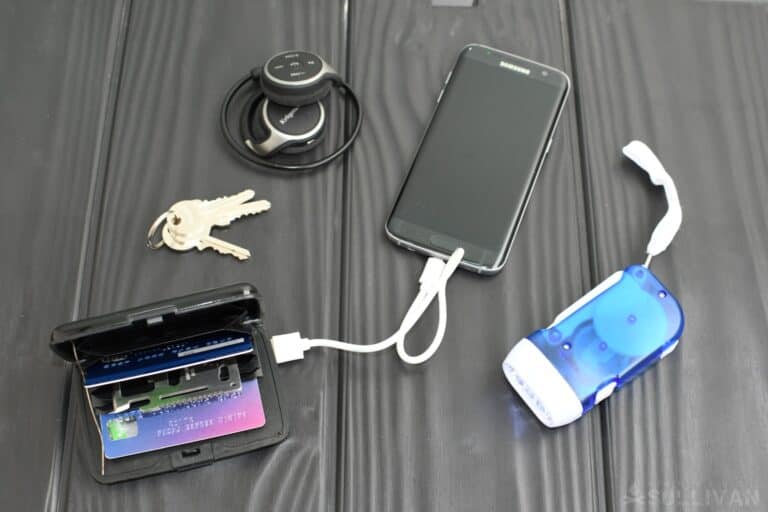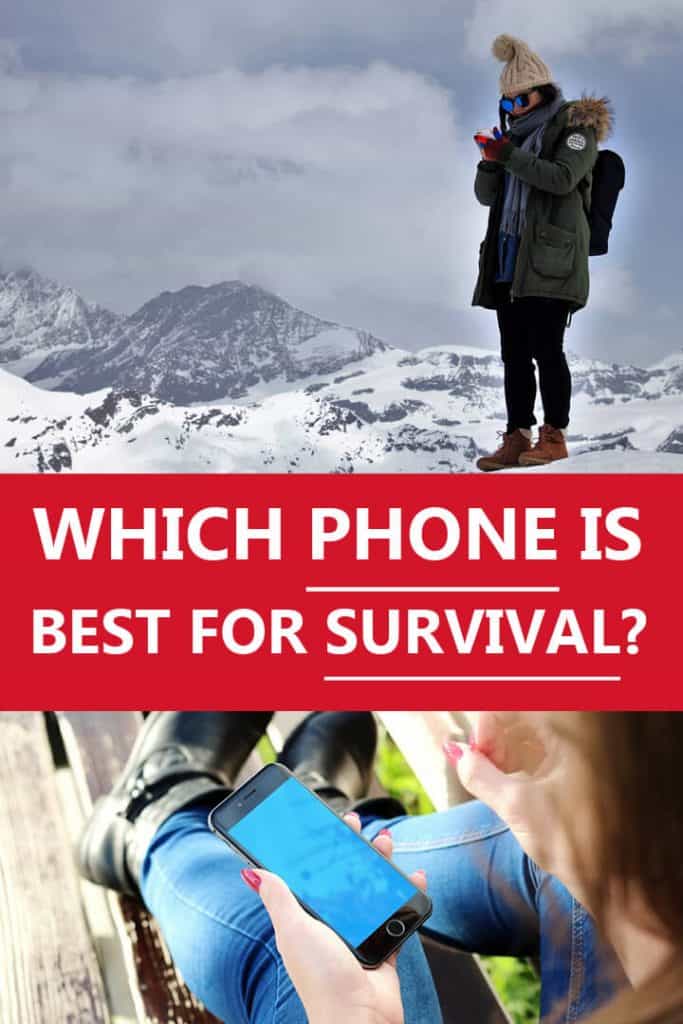Who would have thought a phone can save your life in an emergency? And not necessarily because you’d be able to use it to call for help.
As you’re about to see, your phone can be prepared in a variety of ways to assist you during bug in, bug out, get home, and even wilderness survival scenarios.

Caveat: what about the loss of privacy? It’s no secret that many of the apps and even the mobile operating systems themselves upload a lot of data to their respective owners. While the main reasons have to do with marketing, who knows how companies will use this information in an SHTF scenario.
I’ll leave it up to you to figure out if you really want a smartphone that can help you in disaster scenarios. Also, don’t forget that your device is part of your everyday carry kit (EDC), making your phone that more useful.
Now let’s make your smartphone truly, smart. First things first:
The List of Best Survival Phones
You probably guessed that things like wireless charging or a high-resolution screen aren’t important for what we need. There’s no need to pay 5 or 6 hundred bucks for them. Here’s what you should be really looking for:
- at least 8 GB of memory and storage (preferably 16GB, else you need an SD card),
- a screen of at least 4 inches so you can easily navigate the maps with your fingers,
- a removable battery (so you can keep spare ones in your get home bag, your car, or even your EDC. Phone batteries will also help you start a fire in the, by the way)
- (optional) a pre-paid phone
- FM radio functionality,
- shock resistance,
- water resistance,
- dust resistance
- and, of course, long battery life.
Word of caution: specs can be tricky. No-name phones that have similar specs to high-end phones are lagging in performance so please avoid them. Here’s my full list of survival phones.
Disclosure: This post has links to 3rd party websites, so I may get a commission if you buy through those links. Survival Sullivan is a participant in the Amazon Services LLC Associates Program. As an Amazon Associate, I earn from qualifying purchases. See my full disclosure for more.
The Samsung Galaxy S8 Active

This phone is specifically designed to take a beating. Samsung makes top-notch phones, so you definitely can’t go wrong getting it.
The Caterpillar CAT

Another rugged phone, that’s factory unlocked. However, these are pretty pricey compared to the Samsumg models we just talked about.
CAT S62 Pro

This is a great phone for emergencies. It has a 5.7-inch display, 12-megapixel Flir Thermal Imaging Camera, Android 10, 2.0GHz Qualcomm Snapdragon processor, 6 GB of RAM, a 4000 mAh battery, and a microSD card slot.
Samsung Galaxy Xcover Pro

The Xcover Pro has a 6.3-inch display, 4 GB of RAM and 64 GB of storage, Android 10 OS/CPU. It also has a dual rear camera (25 and 8 MP each), and the 13-MP front camera is just fantastic.
A Cheap, Emergency Phone
Last but not least, a cheap, emergency phone. One with basic functionality, but that’s all you need if you’re stuck in the woods and your main phone is dead. You can get a few of these and just throw them in each of your survival bags.
Are mainstream phones any good?
iPhones and Galaxies are “ok”, provided you get a good shock-absorbing case. Just don’t expect them to last underwater and of, course, expect to pay a premium “because it’s Apple” or “because it’s Samsung”.
Caveat: if you live in an urban area, having a rugged phone will make you stand out from the crowd. People will wonder why you didn’t get a slim one like everyone else. If you’re not going to get an iPhone or a Samsung Galaxy, you can just tell them you’re a camper or that you’ve dropped your phone too many times before and need something more durable).
A Word On Pre-Paid Phones
The problem with prepaid phones is that the minutes expire. Waiting for SHTF to activate the minutes isn’t a good idea, either, because they take too long to activate and besides, in a disastrous situation, they might not work at all.
The best way to go about it is to purchase and activate your pre-paid minutes and then pay a small fee (around 10 bucks a year at T-Mobile) to keep them active.
Accessories for Your Survival Phone
The main thing you’d need is a solar charger but, if you don’t have a rugged phone, you should definitely get a shock-absorbing case such as for iPhone, and Samsung).
Upload the Knowledge
First thing’s first: you should upload your survival manuals. Surely you have e-Books you bought or found on the web for free, useful articles, and so on. Here are some of the things you can do:
- upload PDFs into your phone memory
- bookmark the most useful articles
- install an app such as Pocket to save articles offline on your phone for later use
- get all your survival eBooks on Kindle so they’re available offline
Also, if you have a PDF or a Word Document, you can use a free software named Calibre to convert it to the Kindle format, and then use TotalReader for iOS or CoolReader for Android to view them.
Get the Right Apps
Not all content needs to be uploaded as PDF or read via Kindle. There are various apps that allow you to consume information in an easy manner.
Please note that some of the apps below are for iPhone, even though Apple doesn’t make rugged phones, you can use a good shock-absorbing case if you don’t want to sell it.
Here’s the app list:
- Pocket (we already mentioned it, it allows you to store any article on the web on your phone so you can read it offline iOS link, Android/Google Play link)
- Resuscitate! CPR AED & Choking (iTunes Link)
- First Aid White Cross (Google Play Link)
- Pet First Aid by the American Red Cross (iTunes Link)
- Knot Guide (100+ knots) (iTunes link)
- Knots 3D (Google Play Link)
- the SAS Survival Guide for iPad (link)
- Wild Edibles (iTunes link)
- Edible Plant Guide (Google Play Link)
- the SAS Survival Guide App ( iOS link, Android/Google Play link)
- US Topo Maps Free (Google Play Link)
- Topos2Go (link)
- the Planets app (really cool, check it out on iTunes)
- Commander Compass Lite (iOS link) – this works even without a signal
- an offline GPS navigation app such as the CoPilot or Sygic for iTunes or Sygic for Android
You can find lots of various apps in your app store, just make sure you only install the ones that have good reviews.
Other Uses
Even if your phone stops working, you can still use its parts for various survival tasks:
- the LCD screen as signaling mirrors
- the circuit board or the metal mount as a cutting tool
- wire and the battery to start a fire (touch the wire to both the + and – of the battery and put it next to some kindling) etc.
Final Word
Before I wrap this up, I just wanted to say a few more things. First off, you should never rely on your phone in an emergency. Even if the lines are functional, they’re probably going to be overloaded.
You should definitely have other means of communication such as walkie-talkies, CB radio, or HAM radio.
Second, if you’re looking to store a lot of information, you may want to consider a Kindle device. Not only is it cheap and light but uses very little energy and can be on standby for weeks, even months.
Third, you need to consider EMP and its effects which will render your devices useless.
You can try keeping them in a Faraday cage, but there’s no guarantee they will work. Even if they do, the phone lines will probably be down, so you’ll only be able to use the apps and information you have stored.


My dad was military. My grandfather was a cop. They served their country well. But I don’t like taking orders. I’m taking matters into my own hands so I’m not just preparing, I’m going to a friggin’ war to provide you the best of the best survival and preparedness content out there.

I realize this is bring a post but What phone do you personally carry? And do you like it?
Satellite phone?
Hey, Dan – Enjoy your blog. Good info here. You might wish to consider the Smart One GPS phone. It’s just 50 bucks and a year of service is ony 25 bucks. the good things about it is that it runs on just 2 AA batteries, which are inexpensive and can be found most anywhere. And I like the idea that it runs off the satellites, and is not dependent on the networks, which could go down in a SHTF scenario. I am a 100% disabled vet, and I carry it in my pickup in case I get stranded. Surprised you don’t have it listed here.
Hey there, I tried to find this but the only thing that came up was GPS trackers. Anyway you could provide a link?
Most countries are doing away with 2G meaning this phone won’t work anymore unfortunately. I’m yet to find a 3G or 4G alternative that accepts AA or AAA batteries.
Hey, folks – I made a mistake – it is the Spare One, not Smart One. My bad…
A~
All of these Smartphones are contingent upon all of the cell system staying “up.” Suggest a portable, rugged “police/fire/weather” enabled scanner instead. And/or a portable HAM Band Transceiver, with the requisite & appropriate FCC license.
I really do not put much faith in anything electronic in the event of a SHTF-like event. To believe otherwise requires a LOT of FAITH in someone else’s “system.”
In many countries you can have a pay as you go mobile without having the minutes expire as all you need ro do is make a call at least once a month. But what most people don’t realise is that you only need to MAKE/PLACE a call and the call doesn’t need to be answered.
So use your mobile to phone your landline, Job Done !!
I have loaded Alpine Quest and Offline Maps onto my Galaxy. Both work via GPS and have incredible detail. Additionally, I have a GPS, HAM radio (yes, I’m licensed), and walkie talkies. The one thing I don’t have, and am grateful that you pointed it out, is a Faraday pouch. I do have two reliable compasses…just in case! Thank you for your article. I sincerely appreciate everything you write about. Good and informative advice!
“ The problem with prepaid phones is that the minutes expire.”
I have a prepaid tracphone. My minutes have never expired. We usually buy the year card. I guess if my time ran out and I lost the number that I’d lose the minutes on it. So far, that hasn’t happened. At $99 a year, for a Smart TracPhone, it isn’t bad. Oh the phone was $59.
I spent a lot of time copying PDFs to the 128 GB SD card in my Kindle * HD, only to find out that the device couldn’t “see” the files (it shows all the space they occupy as empty), so they are useless there.
Communication Apps for when the internet is down:
(Comm. is via Bluetooth and WiFi. Bluetooth to Bluetooth is a mesh network. It jumps from person to person and WiFi.)
6 Apps To Chat And Text With No Internet Connection Via Mesh Network
https://www.geckoandfly.com/22562/chat-without-internet-connection-mesh-network/
There might be an issue with encryption for one or more of them. I’m thinking of Bridgefy.
I am a HUGE fan of the Samsung Galaxy Active line of phones. I’ve had 3 and only switched in the last month because the charging port gave out. I had that phone since 2017(4 years, and bought it used) and dropped it daily. The problem is that they are now outdated and no longer run updates. This causes the phone to be incredibly slow, some functions/app don’t work, and many new things aren’t compatible with the phone. Samsung made the XCover Field Pro to replace the Active line but it costs a small fortune still.
I have an S3 and 2x S4 smartphones. None of them have active SIM cards for phone use. They are dedicated wrist computers for me. The S3 is much smaller than the S4 physically, and does not have as many sensors.
The S4 has the most sensors of any smartphone before or since, as far as I can find out. That is one of the reasons I kept mine after I broke the screen and got a newer phone (S6 which I hated) under warranty because they were out of the S4s and they were considered old technology.
I had the screen replaced, and then when the price came down for refurbished S4s I purchased a rerubished one. The S3 was given to me when my friend got a new phone and did not want the old one.
All of my phones, including the current S20 something something, are loaded with prepper apps and information. The S20 is used as my phone, however, if there is a major EMP event and it gets fried it is no great loss.
The S3 and both S4s are kept in a mesh Faraday bags from MobileSec Solutions, along with some other communications gear. One-way (receive) as well as 2-way (Amateur, CB, FRS, GMRS, MURS, and Low VHF Band business band)
So, no, I do not depend on the cell system for anything critical. The S4 phones are truly wrist computers. Apps that use the various sensors can provide me with a tremendous amount of information from the world around me, and with a few thumb drives and an OTG dongle, plus extra data cards, I have hundreds of thousands of documents that can be accessed. All kept protected, of course. What information is not in Kindle format or other ebook format is in .pdf format.
The regular office type apps take care of text documents, spreadsheets, simple calculations with the built in calculator, a calendar, and the like.
Other apps, such as two of only five apps I have thought justified buying rather than the free version, the SAS Survival Manual and the SAS Urban Manual, which are well worth it, give me medical information, foraging information, hunting/fishing information, and on and on and on.
I have hard copies of many of the same items, such as several copies of the SAS manuals, as well as the same or equivalent of every other type of information on the phones in paper copies, as well. Along with magnifying glasses and such so I will be able to read them as my eye sight fails.
All the electronic storage is duplicated in several formats for several different platforms, which all have multiple power sources and are all protected.
I almost forgot to mention the the S4s use batteries that can be swapped out and recharged outside the phones. I have several of the batteries, and several chargers, including AC, 12v DC, and solar. Plus I have a few power packs from 5,000 mah to over 50,000 mah, to power the phones and other gear.
Yep. I am a big believer in quality smartphones for prepping. I always have the old tech and no tech options, too.
Just my opinion.